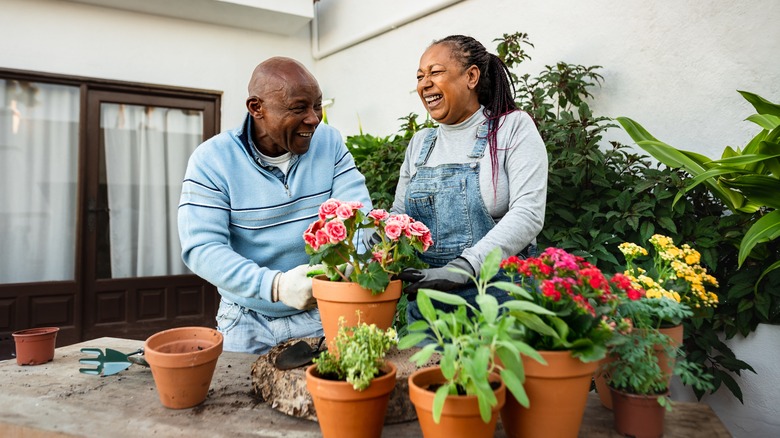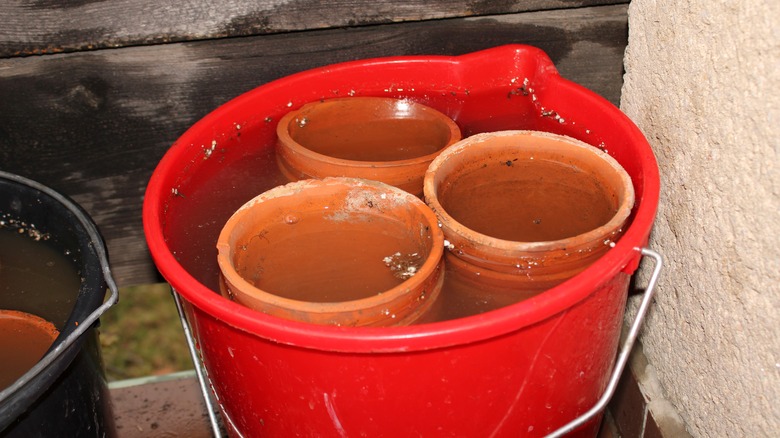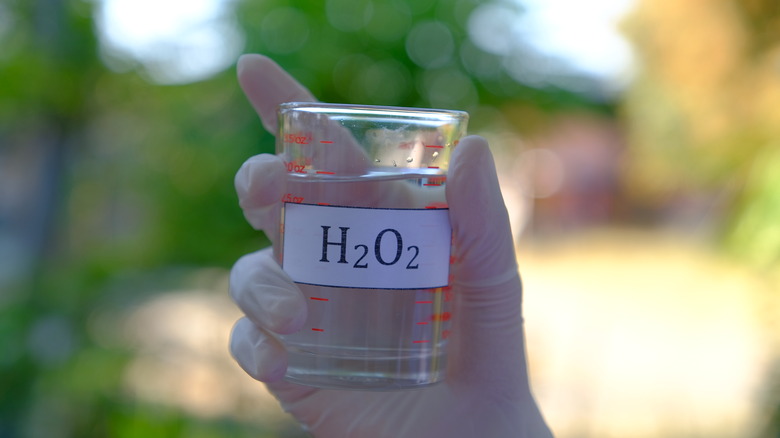Why You Should Be Using Hydrogen Peroxide To Clean Your Garden Pots
We may receive a commission on purchases made from links.
If you're a plant enthusiast, then you probably already know that you should always clean your garden pots before making them the home for any new green friends. This is an important step that can be overlooked by the eager planter but at the sacrifice of your plants' health. By skipping cleaning between uses, any residual soil, pathogens, or pests can continue residing in the pot, posing a risk to your new plants. Skipping this essential step endangers your plants, so it's best to incorporate cleaning your garden pots into your planting routine. As it turns out, you probably already have the perfect ingredient in your first aid supplies to disinfect your garden pots before using them again. All you need is a bottle of hydrogen peroxide to get started.
Hydrogen peroxide is an excellent tool that can help you clean your flower pots by removing any debris that could infect your new plants. It works so well due to the foam it generates when you apply it to the pots. This foam helps lift any remaining residues stuck to the sides of the pot, whether that's dirt, plant matter, or inconspicuous pests. Combining this foaming reaction with physical scrubbing can easily remove any stubborn stains or caked-on matter. Even better, hydrogen peroxide is anti-fungal and antibacterial, so it'll sanitize your pots and reduce the risk of disease transmission to your new plants, too.
How to clean your pots with hydrogen peroxide
The time has arrived to add a bottle of hydrogen peroxide to your gardening supplies. Fortunately, this affordable cleaning solution won't break your bank as it's readily available at most grocery stores and drugstores or even through Amazon for $6.47 for 32 fluid ounces. First, fill a large basin with a 2:1 ratio of clean water to 3% hydrogen peroxide. Submerge your pot, or pots if they are smaller, in the basin and allow them to sit for a minimum of 5 minutes for the peroxide to work its magic and disinfect. You should notice that any debris coating the pots' surface should start to bubble, indicating that the peroxide is working. If your hydrogen peroxide isn't fizzing, it may be past its expiration date and won't be effective. You may want to let extremely dirty pots soak for a few hours or even overnight to allow the solution to lift the dirt from the surface.
Once your pots have thoroughly soaked in the solution, remove them from the basin and scrub them with a clean sponge or scrub brush. Be sure to wear gloves to protect your hands from the peroxide. At this point, the debris on the pots should come off with ease, but if not, you may either want to repeat soaking or add a fresh 2:1 water to peroxide solution directly onto the surface of the pots to help you scrub away any remaining dirt. Dry the pots thoroughly when finished.
Cautions for using hydrogen peroxide
With any cleaning solution, there are important steps you should take to protect yourself from coming into contact with any hazardous fumes or burns. Hydrogen peroxide is no different. While using this product, it's important to use both protective eyewear and gloves. Indeed, peroxide is often used as an antiseptic, so minor interactions with the liquid won't necessarily burn your skin. That being said, prolonged exposure to it may irritate your hands, so it's best to protect them with gloves while you scrub your pots.
On that note, when working with hydrogen peroxide as a cleaning solution, it's essential to dilute it. On its own, peroxide can be corrosive to both your skin and the surface of your garden pots. Therefore, to properly disinfect surfaces like those of your garden pots, it's best to dilute hydrogen peroxide to at least a 1:1 ratio of water to peroxide. For higher concentrations, it's best to adhere to any manufacturer's guidelines on proper dilution proportions before using it to clean or disinfect.
Finally, never mix hydrogen peroxide with other cleaning agents. Many cleaning products are incompatible and can produce toxic fumes, corrosive solutions, or even explosions if mixed together. It may seem harmless to mix peroxide with other innocuous household products like vinegar, but this combination can actually create peracetic acid, which is highly corrosive and potentially lethal depending on your exposure. Stick to one cleaning solution to safely clean your garden pots.


